Hi all,
I thought I would take a few minutes to update everyone on the past experiments I have done.
Ovaltine Brew:
This was interesting. After about a month in the fermenter I bottled it with a teaspoon of sugar in each bottle. After another 2 weeks I tried it. Here are my notes:
Pour is thick, head and carbonation is very good and not unlike commercial dark ales. Smell is slightly malty, light hop aroma and some other undefined smell. It is clear and looks like coke or pepsi. Mouthfeel is kind of thick feeling. Taste is malt in the middle and then some strange (not overly bad) taste. Finish is strong on this flavor. I can't really describe it. I think it is from milk solids? Not cheesy or sour. Strangely there is no hint of cocoa or chocolate taste whatsoever.
I was expecting more of a malty chocolate taste with this brew, but it didn't work out. It's all gone now, so it must have been okay. I will do some research into what the milk and vegetable oil does when aged.
Mead (Pineapple Melomel)
My mead is still resting in bottles at my old neighbors house. I did taste some before bottling and it was wicked strong stuff. Like a vodka and pinepple drink with a shot of white wine. The hops settled out well. Unfortunately we moved and I could not justify taking the bottles of mead with me. My neighbor will put them to use around Christmas time.
My dark ale from extract was excellent! All gone, sorry. I will have to find some malt extract to go with my remaining hops.
Cheers!
Friday, July 20, 2007
Sunday, July 8, 2007
Look North...Way North!
Relocating is never easy and certainly a different buzz in the Philippines. Now here we are in Luzon and the past months have brought many changes including getting married.
The move to Luzon has come a cost in some brewing equipment and I am now going to start hunting around Metro Manila for vessels and what-nots. It is now equipment and supplies hunting mode, Luzon style. Of course I am going to be looking for brewing supplies too and I'll let everyone know what I find.
Cheers!
Relocating is never easy and certainly a different buzz in the Philippines. Now here we are in Luzon and the past months have brought many changes including getting married.
The move to Luzon has come a cost in some brewing equipment and I am now going to start hunting around Metro Manila for vessels and what-nots. It is now equipment and supplies hunting mode, Luzon style. Of course I am going to be looking for brewing supplies too and I'll let everyone know what I find.
Cheers!
Monday, April 30, 2007
Mashing in a Bag? Yup, Crazy Aussies
 Brew in a Bag?
Brew in a Bag?While surfing the homebrew forums I came across this great idea that is being refined in Australia and is sweeping the homebrewing world. It is called Brew in a Bag or BIAB. It's a very simple technique for mashing in the kettle with a bag made of fine-weave polyester. The water is added to the kettle, then the bag, then the milled grains go into the bag. When mash temperature is correct, the whole thing is covered up for 90 minutes. If temperature adjustments are needed, just a burst of flame to get the temp up again is required.
After mashing, you simply (with some physical effort mind you) lift the bag o'grains out and let them drain into the kettle. No sparge required. I did read an article from a guy in Florida that sparged as well with high efficiency. Once the wort is sitting pretty in the kettle, fire up the gas and boil as normal, adding hops etc. Chill, aerate and pitch the yeast.
There is some issues raised with the fact that the mash is so thin (like 30 plus litres of water) and the pH of the mash. The mash is usually much thicker (less water for the grain) . This has been addressed by the authors of a very well put together document on AussieHomebrewer.com. For pictures and play-by-play see this site.
The biggest benefit of BIAB is the cost. A picnic cooler can set you back a few bucks and if everything is working with your extract brews why bother playing with all-grain?
Today, I am going to see if I can find some polyester fabric so I can give this system a try. I will also try an experiment with a polypropylene woven seed bag. That is about the right size for my smaller stock pot.
Gee, I also need to start malting again, so it's off to the barley shop. Wish me luck!
Happy brewing!
Labels:
all-grain brewing,
BIAB,
brewing in a bag,
polyester,
simple brewing
Friday, April 27, 2007
Mid-Week Nano Brews
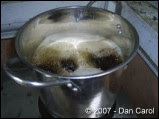 Un-Mega Brewing
Un-Mega Brewing Not all of us have 8 hours to whip up a 5 gallon all-grain batch, even if it is Saturday. Everything takes longer, mashing, sparging and with big batches; longer to boil, longer to chill, longer to clean up. This is why I like to do a Mid-Week Nano Brew. OK, this is only a starter for you 10 gallon brewers out there, but I enjoy brewing.
I often do a 4 litre (about a US gallon) extract batch in about 2 hours and that includes clean up. It's easy, fast and versatile and gives me choices when I ask my friends "what kind of beer do you want?" It also gives me plenty of opportunity to experiment with recipes, changing hop schedule, different yeast strains or trying an unusual ingredient or fruit like mango. I should also note that little batches are ideal for the homebrewer in the tropics who wants to brew a real lager, but cannot afford the dedicated fridge. A small fermemter can be worked into your existing fridge by moving things around. By the way, my 4 litre nano-fermenter is nothing fancy. It is actually a PET water bottle with a airlock fitted to the lid! I chuck a kitchen towel or t-shirt over it to keep the light out. Very convenient, see the photo below.
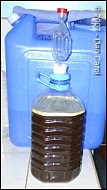 Brew -2 hours
Brew -2 hours Start with 4 litres of bottled water in a soup pot. Bring to a boil and stir in 500g of dry malt extract. It only takes a pinch (like 1/2 teaspoon) of higher alpha bittering hops and boil away. In 45 to 50 minutes add another pinch of some finishing hops and you're almost done.
By this time, if you've kept the lid off the pot, you'll have about 3.5 litres. In the last 15 minutes you can cover or leave the lid off to get about 3.5 litres total wort in your pot. In my nano-chilling regime I use a cold water bath and I add 500ml of santized ice, so 3.5 litres is perfect for my 4 litre nano-fermenter.
I prepare my sanitized ice bags, 500ml each, the day before. I buy "ice bags" at the supermarket and fill them with boiled/cooled water. Into the freezer overnight and they are hard in the morning. As long as you handle them correctly and don't let the bag touch your wort, you should be fine. Stir the ice in with the thermometer and watch the temperature drop .
While I am chilling in the bath, I am readying my starter in the 4 litre mini-fermenter. I rehydrate the yeast directly in the sanitized fermenter and add the cooled wort on top. Simple as pie. Shake the heck out of it to aerate. It's so nice and lightweight.
Because the batches are nice and small you can often brew another batch to go on top of the dregs from the last batch. If your sanitation is good, this is another good way to get some extra mileage from your hard-to-come-by yeast. It will be ripping in no time. Place your nano-brew in a cool, dark place for a few days and it will be beer.
Today I made a very basic dark ale from 500g of dark DME, some hops (Magnum and Cascades), some Cooper's yeast and of course some drinking water. It doesn't get more basic than this. Basic beer recipes usually work good.
In the time it took me to write up this blog, it looked like this.

I am happy to have any kind of dark beer here in the Philippines.
If I made it,
it tastes even better.
Today I made a very basic dark ale from 500g of dark DME, some hops (Magnum and Cascades), some Cooper's yeast and of course some drinking water. It doesn't get more basic than this. Basic beer recipes usually work good.
In the time it took me to write up this blog, it looked like this.

I am happy to have any kind of dark beer here in the Philippines.
If I made it,
it tastes even better.
UPDATE: 6:13 PM...
When she goes mad with krausen, attach a 3/8" (10mm) hose and let it blow into a cup or something. This Cooper's yeast is lovin' it! See photo.

Cheers!
Wednesday, April 25, 2007
Making Invert and Belgian Candi Sugar
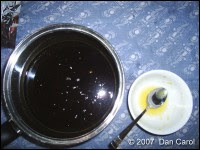 I am living on an island where sugar is cheap and sugar refining is big business, so it's not unusual to want to play with sugar in brewing. I'm not a big fan of the cider flavours of plain old cane sugar but I have enjoyed small additions of caramelized invert sugar.
I am living on an island where sugar is cheap and sugar refining is big business, so it's not unusual to want to play with sugar in brewing. I'm not a big fan of the cider flavours of plain old cane sugar but I have enjoyed small additions of caramelized invert sugar.Inverting the sugar means converting cane sugar's sucrose into fructose and glucose by using an acid like citric acid. The sugar is boiled for 30 minutes on low heat in a little bit of water. Caramelizing is the oxidization of sugars and creates more interesting and complex flavours. In the Belgian style beers, candi sugar is used to increase alcohol content, impart a variety of colours and flavours and create a lovely dense mousse-like head.
In darker beers I like to use a small amount, say 500g of dark brown sugar (muscovado) or light brown sugar (demarama). I will usually mix these half and half with white sugar and caramelize to create a nice complex sweetness. My recipe for my half and half sugars is like this:
250g white sugar
250g demarama sugar
2 tbs calamansi juice (or 1 tsp citric acid)
water to cover
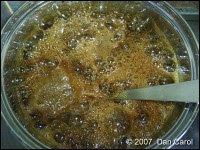 Put sugar and calamansi (or lemon or lime) juice in a pot. Add water just to cover. Stir and heat on low. Keep boiling it on low. Add a tablespoon of water occasionally as the syrup gets too thick. As the sucrose reacts with the water and acid (citric acid) it becomes fructose and glucose. As the heat is applied the sugars oxidize and burn slightly, called caramelization. Caramelization produces interesting flavors in beer as some of these flavours appear in the finished product. After the sugar is the desired colour or flavour turn up the heat a little to remove any excess water. Pour the thick syrup onto some baking paper and allow it to cool and solidify. Store in plastic bags in the fridge and have it ready for brew day.
Put sugar and calamansi (or lemon or lime) juice in a pot. Add water just to cover. Stir and heat on low. Keep boiling it on low. Add a tablespoon of water occasionally as the syrup gets too thick. As the sucrose reacts with the water and acid (citric acid) it becomes fructose and glucose. As the heat is applied the sugars oxidize and burn slightly, called caramelization. Caramelization produces interesting flavors in beer as some of these flavours appear in the finished product. After the sugar is the desired colour or flavour turn up the heat a little to remove any excess water. Pour the thick syrup onto some baking paper and allow it to cool and solidify. Store in plastic bags in the fridge and have it ready for brew day.If you are using basic white sugar it will take about 20 to 30 minutes of low heat to produce an amber coloured candi sugar. In 45 minutes the syrup will begin to appear orange. It can take over 1 hour to produce dark red candi sugar, so be patient and watch the pot all the time. If you have a thermometer, try to maintain 120ºC (ºF) . An oven style, dial face, meat probe works good. If you have a candy thermometer, even better.
Increasing gravity
As a rule, 1 pound of sugar in 1 gallon of water is 1.046 (46 gravity points). In metric this is about 120 grams per litre. Adding a kilogram of inverted sugar to a standard batch of beer adds about 15 points. Depending on the Terminal Gravity (TG), this increase in gravity can increase alcohol content by over 2%. The Belgian ales, dubbels and triples are high-strength beers often above 7% and some exceeding 10% alc./vol.
Sweet eh?
Feel free to experiment with candi sugar or a homemade facsimile in your brewing. Start on the light side though, too much sugar can give your beer an alcohol boost, but it can also make your beer taste like wine.
Cheers,
Labels:
Belgian style,
brewing,
candi,
caramelizing,
demarama,
homebrew,
muscovado,
sugars
Coco-Krausen: Brewing with Ovaltine
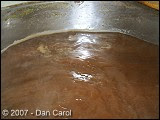 Crazy for Coco-Krausen?
Crazy for Coco-Krausen?As part of my Ovaltine experiment, I brewed a bigger 12 litre batch yesterday. I also boiled up some invert sugar to go with it. Here are the details of the Brewing a Beer with Ovaltine Experiment. The recipe became more complex as I fiddled with it. Maybe I should have kept is simple stupid, but I love the complexities.
I started with 1.2kg of Ovaltine in 10 litres of water. This has a specific gravity of about 1.050 in the kettle, if my calculations (guesses) are correct. This gravity is ok for hop utilization. I boiled it hard for 15 minutes and scooped the fat and protein that separated and floated in the foam. I take it that whey powder and milk solids were the grey blobs that were floating up on the side of the pot.
 I added 14g of Nugget hop pellets at 15 minutes. I then let it roll hard for another 30 minutes before adding 14g of Cascades as finishing hops. With about five minutes left in the hour-long boil I added 500g of inverted, caramelized brown sugar which I made while watching the boil.
I added 14g of Nugget hop pellets at 15 minutes. I then let it roll hard for another 30 minutes before adding 14g of Cascades as finishing hops. With about five minutes left in the hour-long boil I added 500g of inverted, caramelized brown sugar which I made while watching the boil.These are the added ingredients that I did not plan on until the last minute. I also added 2 teaspoons of instant coffee and 1 teaspoon of cinnamon. Apparently, cinnamon in an antioxident and hey, I like Ovaltine in my coffee, so it can't be all that bad. I finished the boil and chilled in a bucket of ice water. I added the thick wort the fermenter and added fresh water to 12 litres. I shock it like mad and picthed a package of Munton's Gold ale yeast that I had rehydrated earlier.
 For being a fairly high-gravity brew (1.080?), it was roaring in a few hours! The zillions of happy yeasts were chowing on the chocolate wort making some kind of coco-krausen. See photo. It's been a day and a bit and the experiment seems to be going ok. The smell from the fermenter is of malt, chocolate, hops and fruit. I am guessing that the fruity aroma is coming from some kind of reaction with the cocoa? Or perhaps the inverted, caramelized brown sugar? Anyways, it sure smells good.
For being a fairly high-gravity brew (1.080?), it was roaring in a few hours! The zillions of happy yeasts were chowing on the chocolate wort making some kind of coco-krausen. See photo. It's been a day and a bit and the experiment seems to be going ok. The smell from the fermenter is of malt, chocolate, hops and fruit. I am guessing that the fruity aroma is coming from some kind of reaction with the cocoa? Or perhaps the inverted, caramelized brown sugar? Anyways, it sure smells good.When the fermentation is complete, I will rack into a secondary with some gelatin in it. I hope to be able to clear the beer, but have not researched much in the way of finings yet. This is a comepletely different kettle of coco compared to real beer brewing.
Happy brewing!
Labels:
ale yeast,
beer,
boil,
experiment,
home brewing,
hops,
ovaltine
Monday, April 23, 2007
Wacky Ovaltine Beer Experiment
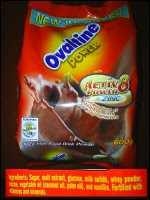 Malted Milk
Malted MilkMost of you will know what Ovaltine is. It's a malted milk drink powder that you mix with water or milk. In the UK Ovaltine is popular, in other parts of the world, Nestle's Milo is popular. After doing some research, reading packages, nutrition web sites, ingredients, etc., I've come up with an experiment to use Ovaltine as a base for beer. If you hadn't guessed it already, malt extract is a big part of these malted milk drink mixes. I will brew up a small batch and experiment with a recipe that I have formulated to make what is essentially 4 litres of some kind of strange chocolate ale.
Here's what I am thinking...
Boil up 500g of Ovaltine in 5 litres of water. I don't know if the yeast will have enough nutrients from Ovaltine alone, so I'll chuck in a teaspoon of dry bakers' yeast in the boil. Add a pinch of bittering hops, boil some more and add some finishing hops, cool, aerate and pitch an ale yeast on it. After a week, I'll rack it onto some gelatin and see how she clears. It will very likely taste like beer as Ovaltine's principal ingredients are sugar, malt extract and glucose.
Here are the ingredients from the label of the Philippines version of Ovaltine:

The ingredients that are bad for beer have little Xs near them, the ingredients that are not bad for beer have little check marks. Sounds pretty neat eh? I'll be take lots of notes and preparing a detailed blog entry to keep everyone aware of what's happening in the laboratory. LOL
Sleep now, it's been a long day.
Labels:
ale,
beer,
chocolate ale,
dry malt extract,
malted milk,
milo,
ovaltine
Subscribe to:
Posts (Atom)
